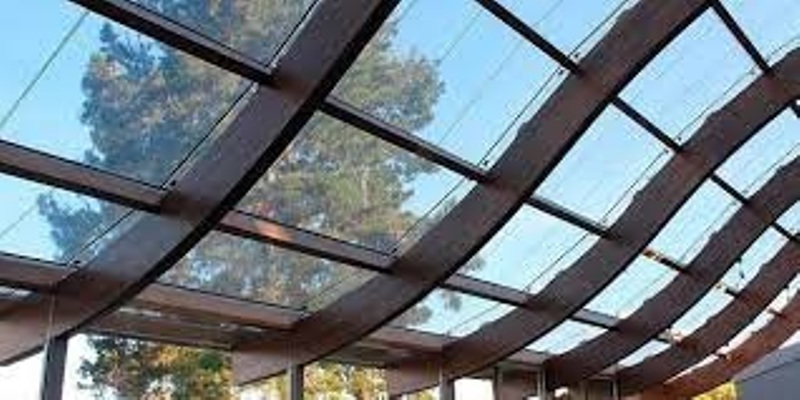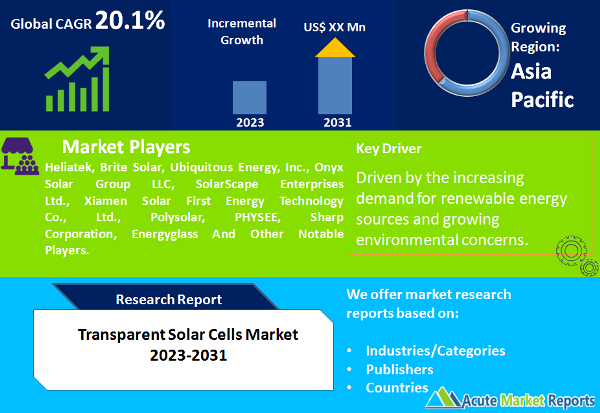
Transparent solar cells have emerged as a groundbreaking technology, offering a unique blend of energy generation and transparency. These innovative photovoltaic cells are designed to capture solar energy while allowing light to pass through, making them suitable for a wide range of applications, from building-integrated photovoltaics (BIPV) to consumer electronics. The transparent solar cells market has witnessed remarkable growth in recent years, driven by the increasing demand for renewable energy sources and growing environmental concerns. These cells are engineered to harness solar energy efficiently without compromising visibility, making them a versatile solution for diverse applications. Transparent solar cells marketis projected to advance at a CAGR of 20.1% from 2025 to 2033, driven by rising energy demand, technological advancements, and integration opportunities in architectural design.

Rising Energy Demand and Environmental Concerns
One of the primary drivers of the transparent solar cells market is the increasing global demand for energy. With the depletion of fossil fuels and concerns about climate change, there is a growing need for clean and sustainable energy sources. Transparent solar cells offer a promising solution by efficiently harnessing solar energy without compromising aesthetics or functionality. This technology aligns with the goals of reducing carbon emissions and promoting green energy solutions. Evidence of this driver can be observed in the increasing investments and government incentives for renewable energy projects worldwide, coupled with a rising number of eco-conscious consumers adopting transparent solar technologies.
Advancements in Solar Cell Technology
Technological advancements have played a pivotal role in driving the growth of transparent solar cells. Researchers and manufacturers have made significant progress in developing more efficient and cost-effective transparent solar materials and manufacturing processes. Thin-film photovoltaics (TPV) and polymer solar cells, among other innovative cell types, have witnessed substantial improvements in conversion efficiency and transparency levels. These advancements have led to a wider range of applications and increased adoption of transparent solar cells in architectural designs, consumer electronics, and even transportation. The evidence of this driver can be seen in the continuous innovation and patent filings in the transparent solar technology sector.
Integration Opportunities in Architectural Design
The integration of transparent solar cells into architectural designs is another significant driver of market growth. Architects and designers are increasingly recognizing the aesthetic and functional benefits of transparent solar materials. These materials can be seamlessly incorporated into building facades, windows, and skylights, allowing structures to generate electricity while maintaining a visually appealing appearance. Additionally, the energy generated by these integrated systems can contribute to reducing a building's overall energy consumption and costs, making them an attractive option for both residential and commercial applications. The evidence for this driver can be found in the growing number of architectural projects worldwide that incorporate transparent solar technology, alongside the positive feedback and energy savings reported by building owners.
Cost and Efficiency Challenges
Despite the promising growth of transparent solar cells, one significant restraint is the ongoing challenge of cost-effectiveness and efficiency. Transparent solar materials, particularly those with high transparency levels, often come at a higher cost compared to traditional solar panels. Additionally, their energy conversion efficiency is generally lower than conventional solar cells. Overcoming these challenges is crucial for wider market adoption. Evidence of this restraint can be observed in the slower adoption rate in regions with stringent budget constraints and the ongoing research efforts to improve the cost-to-efficiency ratio in transparent solar cell production.
Polymer Solar Cell Dominates the Market by Cell Type
Transparent solar cells come in various types, each with its unique characteristics and advantages. Thin-film photovoltaics (TPV) are known for their flexibility and lightweight properties, making them suitable for curved or irregular surfaces. Polymer solar cells, on the other hand, offer improved transparency and can be integrated into a wider range of applications. Other emerging cell types, such as organic photovoltaics (OPV), show promise in achieving higher efficiency and cost-effectiveness. In terms of market performance, TPV currently holds the highest compound annual growth rate (CAGR) due to its versatility and growing adoption, while polymer solar cells lead in terms of revenue generation, driven by their transparency and broader applicability.
Semi Transparent Segment Dominates the Marketby Transparency Level
The transparency level of solar cells varies based on the specific application requirements. Highly transparent solar cells are designed to maximize transparency while maintaining solar energy capture. They find applications in windows and facades where aesthetic considerations are paramount. Semi-transparent cells strike a balance between transparency and efficiency, making them suitable for applications where both aesthetics and energy generation are important. Tinted or colored solar cells, while providing some level of transparency, prioritize aesthetics over energy generation. In the market, highly transparent cells are witnessing the highest CAGR due to their increasing adoption in architectural projects, while semi-transparent cells generate the highest revenue, particularly in consumer electronics and automotive applications.
Asia Pacific Remains as a Global Leader in terms of Revenue
Geographically, the transparent solar cells market exhibits distinct trends. North America and Europe have been leading in terms of adoption, with a high CAGR driven by government incentives, green building initiatives, and growing environmental awareness. In terms of revenue percentage, Asia-Pacific dominates the market due to its massive population and increasing demand for sustainable energy solutions, particularly in emerging economies like China and India. These regions are expected to continue their growth trajectory in the coming years.
Competitive Trends
The transparent solar cells market is characterized by intense competition among key players. Some of the leading companies operating in this space include Heliatek, Brite Solar, Ubiquitous Energy, Inc., Onyx Solar Group LLC, SolarScape Enterprises Ltd., Xiamen Solar First Energy Technology Co., Ltd., Polysolar, PHYSEE, Sharp Corporation, and Energyglass. These companies employ various strategies, including partnerships, product innovations, and mergers and acquisitions, to gain a competitive edge. In 2024, these players reported substantial revenues, and in the expected forecast period from 2025 to 2033, they are anticipated to further strengthen their market positions by capitalizing on the growing demand for transparent solar technology.
Historical & Forecast Period
This study report represents analysis of each segment from 2023 to 2033 considering 2024 as the base year. Compounded Annual Growth Rate (CAGR) for each of the respective segments estimated for the forecast period of 2025 to 2033.
The current report comprises of quantitative market estimations for each micro market for every geographical region and qualitative market analysis such as micro and macro environment analysis, market trends, competitive intelligence, segment analysis, porters five force model, top winning strategies, top investment markets, emerging trends and technological analysis, case studies, strategic conclusions and recommendations and other key market insights.
Research Methodology
The complete research study was conducted in three phases, namely: secondary research, primary research, and expert panel review. key data point that enables the estimation of Transparent Solar Cells market are as follows:
Market forecast was performed through proprietary software that analyzes various qualitative and quantitative factors. Growth rate and CAGR were estimated through intensive secondary and primary research. Data triangulation across various data points provides accuracy across various analyzed market segments in the report. Application of both top down and bottom-up approach for validation of market estimation assures logical, methodical and mathematical consistency of the quantitative data.
| ATTRIBUTE | DETAILS |
|---|---|
| Research Period | 2023-2033 |
| Base Year | 2024 |
| Forecast Period | 2025-2033 |
| Historical Year | 2023 |
| Unit | USD Million |
| Segmentation | |
Cell Type
| |
Transparency level
| |
End-User
| |
Application
| |
|
Region Segment (2023-2033; US$ Million)
|
Key questions answered in this report